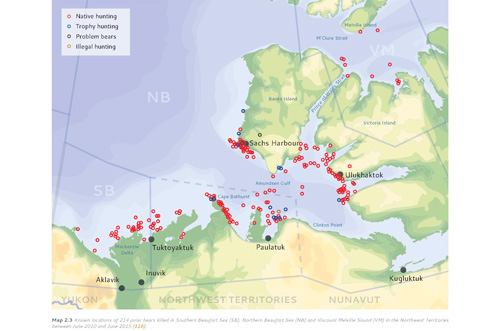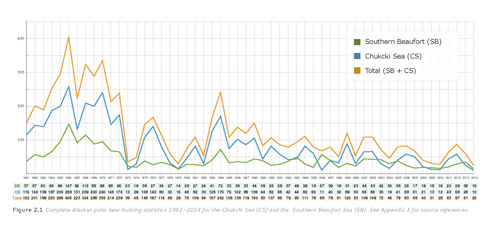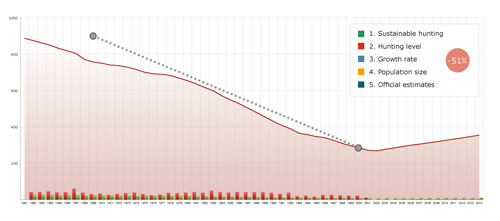Your cart is currently empty!
Polar Bears and Humas Old
Introduction
[columnize]
Polar bears and humans have a long history in most parts of the Arctic. Ever since the Inuits encountered the polar bears hundreds of years ago, there has been more and more interaction with this large predator. Today, hunting, scientific activity and tourism are directly interfering with the life of the polar bears. Climate change and pollution, also linked to human activity, is also affecting the Arctic King.
The big question is, how this human activity is affecting the polar bears. How does climate change affect the survival and opportunities for polar bears? How many polar bears are killed annually? Is this hunting sustainable? Is the population of polar bears decreasing or increasing? Is the current polar bear management successful? Are there any red flags regarding the trade of polar bear skins? Are there any alternatives to hunting for the Natives? These are some of the important questions very few authors, researchers and organizations are asking. In this project we want to publish information about these topics, and address important conservation actions.
The first outcome of this project will be a high quality book (format 29×26 cm) that will combine scientific facts, photo stories and interviews. Since there is scarce literature containing comprehensive reports or “written knowledge” on these topics available today, this book will be important to drive involvement of people and organisations in Arctic conservation. Ole J. Liodden is the founder of this project and will be the main author and photographer in the project.
[/columnize]
The problem
[columnize]
Most of the Polar bear conservation projects today are only focusing on climatic changes and global warming. It is very important to protect the Arctic environment and ecosystem to secure the drifting ice for future animals, but it is also important to protect the animals themselves. Polar bears have become the main symbol for global warming, and big conservation campaigns are published with images of skinny polar bears. Human removals (killing) of polar bears are rarely mentioned in these campaigns.
A big problem when working with polar bear conservation is the fact that information about polar bear hunting is hidden, very limited, only available for shorter periods or only referred to as “sustainable” without any concerns. There are no books, research papers or internet publications available today with detailed, long-term hunting statistics at village or polar bear sub-population level. This makes it difficult to talk about polar bear hunting, since important information about this activity is not available.
Projects about the interaction between polar bears and humans might be challenging, since many people have strong feelings about polar bears, hunting, native people and climate change issues. It is politically incorrect to question the Inuit, scientific activity, or the polar bear management – especially in areas with hunting.
[/columnize]
Living on thin ice
[gap size=”0px”]
The ocean temperature is rising, the Arctic ice coverage is shrinking and the drifting ice is getting thinner. In this project we want to look into how serious is this change? How does it affect the polar bears and other Arctic animals? How can the polar bears adapt to this new future?
Many books and scientific papers have been published about climate change, but there is not much information available on how this affects the polar bears regarding their growth rates (population changes), their choices on thin ice and the kind of ice that is most limiting for their existence.
Living on thin ice
The ocean temperature is rising, the Arctic ice coverage is shrinking and the drifting ice is getting thinner. In this project we want to look into how serious is this change? How does it affect the polar bears and other animals? How can the polar bears adapt to this new future?
Many books and scientific papers have been published about climate change, but there is not much information available on how this affects the polar bears regarding their growth rates (population changes), their choices on thin ice and the kind of ice that is most limiting for their existence.
The history of hunting
[columnize]
Polar bears have been hunted for hundreds of years by the Inuit. Since 1850 European hunters and trappers have also hunted polar bear intensively, and from the 1950s onwards, trophy hunters have killed hundreds of polar bears. After the Agreement on the Conservation of Polar Bears in 1973, there have been some improvements, at least in Svalbard, but 800-1000 polar bears are still shot every year – legally or illegally. For most of you this is a shockingly high number, and in this project we want to show the historical hunting levels, where this hunting occurs and who are the most active hunters.

[/columnize] [gap size=”50px”] [columnize]

Hunting statistics for the last 50 years are “official” but extremely difficult to find, or sometimes even hidden. A fraction of hunting statistics can be found in scientific publications, but no complete timeline can be found with detailed information. One of the main purposes of this project is to publish complete time series (1962-2014) of polar bear hunting activity in Alaska, Canada, Greenland and Svalbard. Based on this information and growth rates, it will be possible to estimate population changes over time.
[/columnize]
Population trends
[columnize]
The “official” number for the total polar bear population is 20.000-25.000, but this number is mostly based on old counting and estimates. Very few researchers or authors have tried to provide updated estimates for the polar bear population today. Two important questions are: why is it so important to know the numbers of polar bears, and how can the management and organization talk about “sustainable hunting” when the estimates of polar bear populations are so uncertain?
In this project we want to break down the total number of polar bears into countries and sub-populations, and based on historical hunting statistics and estimated growth rates, calculate population trends. We also want to cover as long time series as possible, back to the 1960s, to see how successful the Agreement on the Conservation of Polar Bears from 1973 has been.

License to kill
[columnize]
Around 100 polar bears are killed annually by trophy hunters in Arctic Canada. With a legal license hunters with enough money can kill a polar bear, with the help from local Inuit guides. This hunting activity has some ethical issues, and has led to a growing movement for an international ban on this activity. In this project we want to look at this trophy hunting business regarding: how many polar bears are killed by trophy hunters in total? Where is this trophy hunting business activity located? How can this trophy hunting be legal within the Agreement on the Conservation of Polar Bears from 1973? Is the trophy hunting activity only in areas with stable polar bear populations? How much are the locals benefiting from this polar bear trophy hunting?
One thing is how to reduce or ban the polar bear trophy hunting, but an even more important question is if there are other options to the traditional trophy hunting. Modern trophy hunters, as we see them in Svalbard, Churchill and Kaktovik, are using cameras instead of guns, and share image prints or digital images of their trophies, instead of polar bear heads or skins in their show rooms. The business of modern trophy hunting will also gain more people in the local communities, not only for the guides and the operator. They can sell the same polar bear more than once, and to more people, year after year. If the local Inuit want to increase their income based on low scale eco tourism, this might be an opportunity in at least some areas, even with expensive logistics.
[/columnize]
In the name of science
[columnize]
The polar bear is a symbol of the Arctic. Since the 1980s, thousands of polar bears have been visited, darted and followed by researchers to obtain data on movements, climate changes and oceanic pollution. Some questions about this scientific activity are: How stressful is it for the polar bears? Is it possible to improve the tracking devices (satellite collars) to reduce the burden on the bears? What have we learned from these scientific studies? Why should we continue some of the programs? Are there any scientific studies we can end? Do we receive the right data for management of the polar bears? Is the Arctic King mainly used as a symbol for raising money for different research and conservation projects?
[/columnize]
The Arctic Rhino
[columnize]
The prices of polar bear pelts are increasing every year, and the markets, especially in China and Russia, are growing. In this project we want to describe the market for polar bear parts (pelts): Who is buying them, who is earning the money and where the pelts are coming from.
What is the future for polar bears if the pelt prices continue to rise? Is there a price limit or “point of no return” where the “bad guys” are entering the business? How will the illegal hunting in Russia and other places respond to this increased demand?
We want to see if there were any similarities between the hunting / poaching of polar bears and African Rhinos (or other endangered species) 10-15 years ago. Are there any “red flags” today? Can we learn something from the African Rhinos or will we soon see the same story with an “Arctic Rhino”?
[/columnize]
Support the project
The Polar Bears & Humans project will not succeed without support from people like you. Not everyone has the time, experience or knowledge to work on a conservation / information project like this, but you can play an important part in it by contributing with a donation. We are very thankful for everyone supporting this project!
By supporting this project you will be directly involved in a project providing important information about polar bear hunting, populations and management, not only another great coffee-table book with great photography. This project is not a typical Kickstarter project where we might run the project if enough people are supporting us. We started to work on the project back in September 2014, and the writing of the book in August 2016. This project is already on the move and your support will not be wasted in administration or nonsense.
It will take 2-3 years to work seriously on the topics addressed above, and at the moment we have 4 stages in this project:
1. Work on the hunting statistics and write the history of hunting. Budget USD $5000. This stage is now 100% funded, and will be finished 28.02.2017.
[gap size=”10px”]2. Work on the population estimates for all 19 sub-populations of polar bears, and include the hunting statistics and link it with estimates for growth rates. Parts of the “Living on thin ice” will also be included. Budget USD $5000. This stage is now 100% funded, and will be finished 30.06.2017.
[gap size=”10px”]3. Work on the “License to kill”, “In the name of science” and the “Arctic rhino” topics. This stage also requires some traveling to make the photo stories and pictures for the book (and hopefully exhibitions). Budget USD $15,000. This stage is 37% funded, and will be finished 31.12.2017.
[gap size=”10px”]4. Write the rest of the text, copy editing, prepare the layout and print the book “Polar Bears & Humans”. Budget USD $25,000. This stage is 0% funded, and will be finished 31.12.2018.
NOTE: Donations up to USD $50,000 will be used for making the book as described above. After these four stages we plan to address further stages through a NGO organization with activities like: Polar bear conservation projects, lobbying decision makers, conferences and exhibitions. We also believe the published information in the Polar Bears & Humans book will be important for other people and organizations working for better protection of Arctic animals and their ecosystem.
[gap size=”50px”]
Polar Bears & Humans book
Rewards for everyone supporting this project:
[content_band style=”color: #333;” bg_color=”#eeeeee” border=”all” inner_container=”true”] [custom_headline style=”margin-top: 0;” level=”h4″ looks_like=”h3″]USD $10 or more[/custom_headline]You will receive a monthly newsletter with status updates about the project, and will get a chance to buy the book later.
[/content_band] [content_band style=”color: #333;” bg_color=”#eeeeee” border=”all” inner_container=”true”] [custom_headline style=”margin-top: 0;” level=”h4″ looks_like=”h3″]USD $100 or more[/custom_headline]
You will receive the regular version of the Polar Bears & Humans book (signed and numbered 1-100) to your address when it’s published.
Estimated delivery: Feb 2019
[/content_band] [content_band style=”color: #333;” bg_color=”#eeeeee” border=”all” inner_container=”true”] [custom_headline style=”margin-top: 0;” level=”h4″ looks_like=”h3″]USD $250 or more[/custom_headline]
You will receive the Limited Edition Polar Bears & Humans book (signed and numbered 1-100) to your address when it’s published.
Estimated delivery: Feb 2019
[/content_band] [content_band style=”color: #333;” bg_color=”#eeeeee” border=”all” inner_container=”true”] [custom_headline style=”margin-top: 0;” level=”h4″ looks_like=”h3″]USD $500 or more[/custom_headline]
You will be listed under “Private sponsors” in the book, and receive the Limited Edition Polar Bears & Humans book (signed and numbered 1-100) to your address when it’s published.
Estimated delivery: Feb 2019
[/content_band] [content_band style=”color: #333;” bg_color=”#eeeeee” border=”all” inner_container=”true”] [custom_headline style=”margin-top: 0;” level=”h4″ looks_like=”h3″]USD $1000 or more[/custom_headline]
Choose 1x Limited Edition print, be listed under “Private sponsors” in the book, and receive the Limited Edition Polar Bears & Humans book (signed and numbered 1-100) to your address when it’s published.
Estimated delivery: Feb 2019 (book), 1 month prints
[/content_band] [content_band style=”color: #333;” bg_color=”#eeeeee” border=”all” inner_container=”true”] [custom_headline style=”margin-top: 0;” level=”h4″ looks_like=”h3″]USD $2500 or more[/custom_headline]
Choose 3x Limited Edition print, be listed under “Private sponsors” in the book, and receive the Limited Edition Polar Bears & Humans book (signed and numbered 1-100) to your address when it’s published.
Estimated delivery: Feb 2019 (book), 1 month prints
[/content_band] [content_band style=”color: #333;” bg_color=”#eeeeee” border=”all” inner_container=”true”] [custom_headline style=”margin-top: 0;” level=”h4″ looks_like=”h3″]USD $5000 or more[/custom_headline]
You (or your company) will be a “Main partner” in the project. Contact us
[/content_band]
Send an email to ojl@oleliodden.com if you have any questions.
Main Partners
[gap size=”50px”]
[column type=”1/3″ fade=”true”][content_band style=”color: #777777;” bg_color=”#eeeeee” border=”all” inner_container=”true”][image type=”rounded” src=”http://oleliodden.com/wp-content/uploads/2017/02/wpw-3.jpg” href=”http://wildphotowonders.de” target=”blank” width=”400″ height=”80″ link=”true” alt=”Wild Photo Wonders” info=”none” info_place=”top” info_trigger=”hover”][custom_headline style=”margin-top: 0;” level=”h4″ looks_like=”h3″ type=”center”][custom_headline style=”margin-top: 0;” level=”h4″ looks_like=”h3″ type=”center”]PEER VON WAHL PEER[/custom_headline][/content_band][/column]